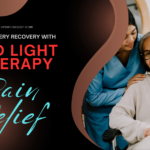
Red Light Therapy for Healing Wounds: Accelerate Wound Healing
Introduction
As I sat in the doctor’s office, I stared at the angry-looking gash on my arm. The stitches were healing slowly, and the pain was constant. Then, my doctor mentioned “red light therapy.” I was skeptical at first, wondering how a simple light could help.
But after learning about it, I was amazed. Red light therapy is a natural, non-invasive way to heal wounds. It has been shown to speed up healing, reduce inflammation, and promote new tissue growth. This means faster, stronger healing with less pain and scarring.
Key Takeaways
- Red light therapy is a safe, natural method to speed up healing for burns, wounds, surgery incisions, and scars.
- It delivers concentrated wavelengths of therapeutic light to skin and cells, reducing oxidative stress and stimulating cellular energy production (ATP).
- Red light therapy has been shown to reduce acute and chronic inflammation, produce new blood vessels, new fibroblasts, and new tissue formation, leading to faster, stronger healing outcomes with less patient pain.
- Studies have demonstrated the effectiveness of red light therapy for a wide range of wound types, including surgical incisions, burn wounds, and diabetic wounds.
- Optimal treatment protocols and application methods are essential to achieving the best results with red light therapy.
Red Light Therapy Healing Mechanisms
Red light therapy is a non-invasive treatment that uses red and near-infrared light. It stimulates your body’s natural healing processes. This therapy helps with wound healing, skin repair, and tissue regeneration.
How Red Light Penetrates Skin Tissue
Red light therapy works by deeply penetrating the skin. The red and near-infrared light reaches the skin’s deeper layers. There, it interacts with the mitochondria, the cells’ powerhouses.
This interaction triggers beneficial cellular responses. These responses promote healing and rejuvenation.
How Red Light Penetrates Muscle Tissue
The red and near-infrared light used in therapy can go deep into muscles. It reaches the mitochondria, starting a chain of benefits for muscle recovery and performance.
Image courtesy of NOVAALAB LLC
The Role of ATP Production in Wound Healing
When skin cells are exposed to red light, they absorb it. This leads to more adenosine triphosphate (ATP) production. ATP is the cells’ energy source.
This energy boost helps cells respond to damage better. It also rejuvenates them, speeding up the wound healing process.
Cellular Response to Red Light Treatment
Red light therapy triggers positive cellular responses. It increases blood flow and improves oxygen and nutrient delivery. It also boosts collagen production.
These effects support the body’s natural healing. They lead to better skin repair and tissue regeneration.
“Research indicates that red light therapy may be effective in relieving pain due to inflammation, based on a review of 11 studies.”
Red light therapy uses the power of red light for natural healing. It helps with wound healing, rejuvenates the skin, and promotes tissue repair.
“A 2018 review found limited evidence that Red Light Therapy (RLT) may help improve skin health and cosmetic appearance by increasing collagen production in the skin, increasing fibroblast production, increasing circulation between blood and tissue cells, reducing fine lines, and reducing wrinkle severity.”
Moreover, its anti-inflammatory effects help with bone fractures and musculoskeletal injuries. With minimal side effects, red light therapy is a promising treatment for many wound issues.
Scientific Evidence
Many studies show red light therapy speeds up healing for different wounds. It works well for surgical cuts, burns, and even diabetic wounds. This treatment is changing how we manage wounds.
Surgical Incisions and Recovery
A study with 90 patients after sternum surgery found red light therapy helped a lot. It made patients feel less pain, cough less, and had fewer bleeding and rupture issues. This compared to those not getting the treatment.
Burn Wound Treatment
Red light therapy is also very effective for burn wounds. It reduces swelling and helps new tissue grow. It also helps make new blood vessels and boosts fibroblast growth, key for healing.
Diabetic Wound Healing
Diabetes makes healing tough, but a trial showed red light therapy can help. It was used with skin grafts on third-degree burns in diabetics. All patients healed without needing amputations.
These studies show red light therapy’s huge potential for healing various wounds. It’s changing wound care and patient recovery. As more evidence comes in, this method is set to make a big impact.
Optimal Treatment Protocols
Using Red Light Therapy for wound healing needs the right treatment protocols and application methods. Research shows that certain wavelengths, power densities, and times are key. They greatly affect how well this therapy works.
A study with a 661 nm diode laser found that 3 – 4.5 J/cm2 energy helped wounds heal faster 24 hours after treatment. The treatment lasted from 5 to 13 minutes. The power was set at 5, 10, and 15 mW/cm2.
The researchers stressed the need for even light and accurate power measurement. This ensures the best results.
It’s vital to follow Red Light Therapy treatment protocols to avoid side effects. These protocols use wavelengths from 630 to 850 nanometers. They also set specific power densities and times based on the person and the wound type.
- Red light ranges from 630 to 700 nanometers, and near-infrared light ranges from 700 to 850 nanometers.
- The success of Red Light Therapy depends on wavelength, power density, and exposure time. These must be carefully set for the best results without harm.
By sticking to these Red Light Therapy treatment protocols and application methods, healthcare experts and people can get the most out of this therapy. It helps wounds heal faster and promotes tissue repair and growth.
Image courtesy of NOVAALAB LLC
Conclusion
Research shows red light therapy can help wounds heal faster. It works for different types of wounds, like cuts, burns, and diabetic ulcers. It boosts cell energy, cuts down inflammation, and helps new tissue grow.
The success of red light therapy depends on several things. This includes the light’s wavelength, where it’s applied, how you react to it, and how often you use it. Knowing how it works can help you decide if it’s right for your wound care plan.
Frequently Asked Questions
What is red light therapy and how can it accelerate wound healing?
Red light therapy is a safe, natural method. It uses special light to help wounds heal faster. This includes burns, wounds, and scars. It works by reducing inflammation and boosting the body’s healing.
How does red light therapy work on a cellular level to aid wound healing?
Red light therapy excites the skin’s cells. This happens when the light is absorbed by the tissue. It leads to more energy in cells, helping them heal faster.
What types of wounds has red light therapy been shown to effectively treat?
Red light therapy helps with many wounds. This includes surgical cuts, burns, and even diabetic wounds. It makes wounds heal faster and stronger.
What are the key scientific findings on red light therapy for wound healing?
Research shows red light therapy reduces pain and bleeding after surgery. It also speeds up burn healing by reducing inflammation. For diabetic wounds, it helped skin grafts heal completely in all patients.
What are the optimal treatment protocols for using red light therapy?
Good red light therapy uses the right light and time. Studies say 3-4.5 J/cm2 energy and 5-13 minutes of treatment work best. It’s also important to measure the light’s power and ensure even coverage.
Additional Information
Additional Information
- https://www.degreewellness.com/2020/05/red-light-therapy-for-healing-injuries-wounds-scars-and-burns/ – Red Light Therapy for Healing Injuries, Wounds, Scars, and Burns – Degree Wellness
- https://my.clevelandclinic.org/health/articles/22114-red-light-therapy – Red Light Therapy: Benefits, Side Effects & Uses
- https://www.webmd.com/skin-problems-and-treatments/red-light-therapy – What Is Red Light Therapy?
- https://www.performancehealth.com/articles/red-light-therapy-101?srsltid=AfmBOor2-R3xVOIYlLn6W7bYlauDytxxelXb-GjNcdiMo8CJagWvK9gK – Red Light Therapy 101
- https://chirorevival.com/demystifying-red-light-therapy-what-you-need-to-know/ – Demystifying Red Light Therapy: What You Need to Know
- https://www.medicalnewstoday.com/articles/325884 – Red light therapy: Benefits and side effects
- https://spinoff.nasa.gov/NASA-Research-Illuminates-Medical-Uses-of-Light – NASA Research Illuminates Medical Uses of Light
- https://pmc.ncbi.nlm.nih.gov/articles/PMC9794538/ – The effects of low power laser light at 661 nm on wound healing in a scratch assay fibroblast model
- https://pmc.ncbi.nlm.nih.gov/articles/PMC4148276/ – Effects of low-power light therapy on wound healing: LASER x LED
- https://www.spectraredlight.com/red-light-therapy-for-wound-healing/ – Red Light Therapy for Wound Healing – Spectra Red Light
- https://rehab.pesi.com/blog/details/2202/how-to-use-red-light-therapy-to-help-patients-thrive – How To Use Red Light Therapy To Help Patients Thrive
- https://www.healthline.com/health/red-light-therapy – Red Light Therapy: Uses, Benefits, and Risks
- https://link.springer.com/article/10.1007/s10103-024-04042-x – The effect of combined red, blue, and near-infrared light-emitting diode (LED) photobiomodulation therapy on speed of wound healing after superficial ablative fractional resurfacing – Lasers in Medical Science
- https://apexchiroco.com/red-light-therapy/harnessing-the-healing-power-of-light-how-red-light-therapy-decreases-pain-and-inflammation/ – Harnessing the Healing Power of Light: How Red Light Therapy Decreases Pain and Inflammation | Apex Chiropractic




































Unlock Exclusive Product Insights: Subscribe Now
Join our community of savvy shoppers! Subscribe to our monthly newsletter for expert reviews, top product recommendations, and exclusive deals delivered straight to your inbox. Don’t miss out on discovering the best products on the internet – sign up today and start shopping smarter!
You have Successfully Subscribed!
We promise not to spam you - only quality content to help you discover the best deals on the internet! Absolutely Free.